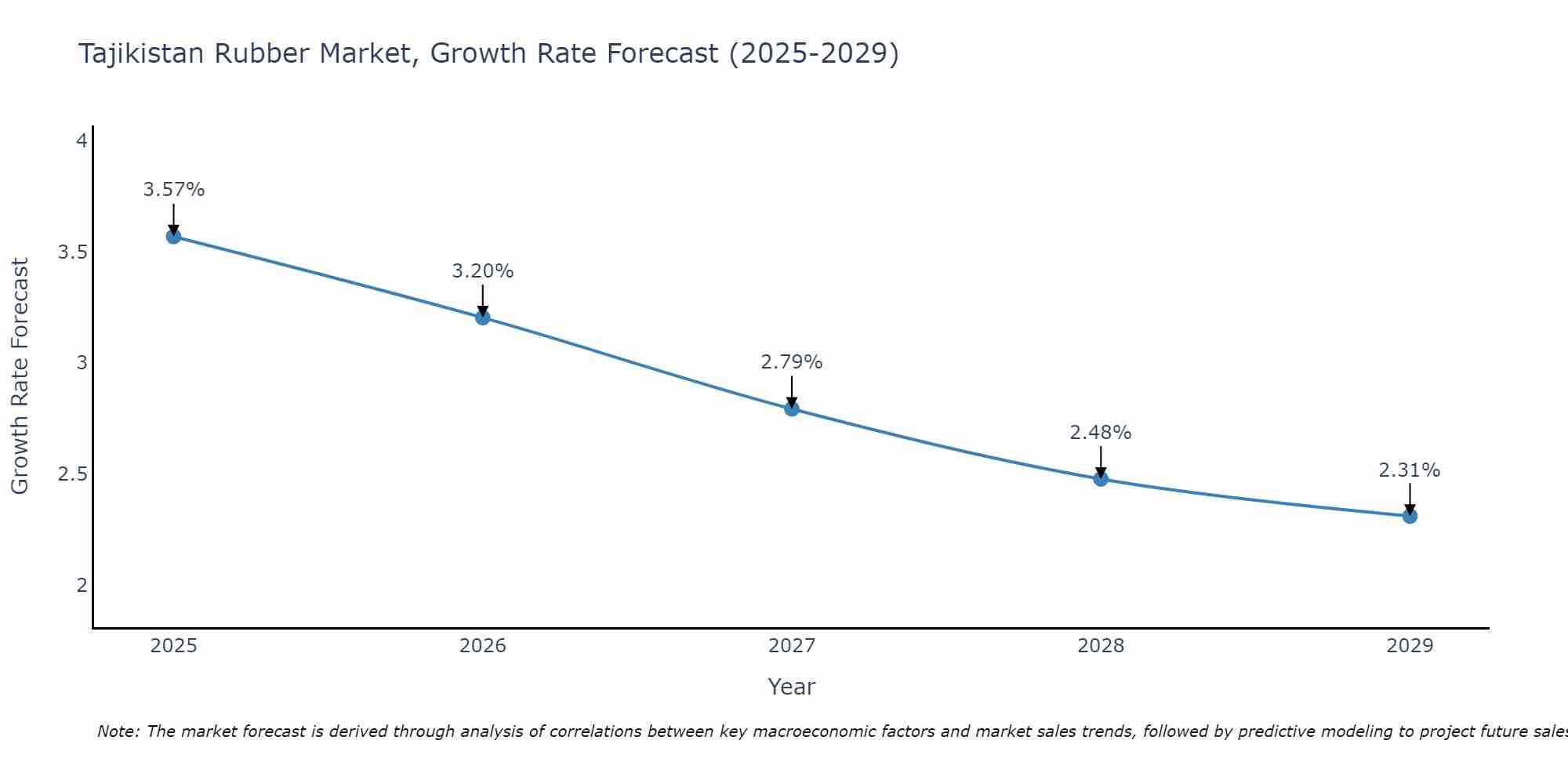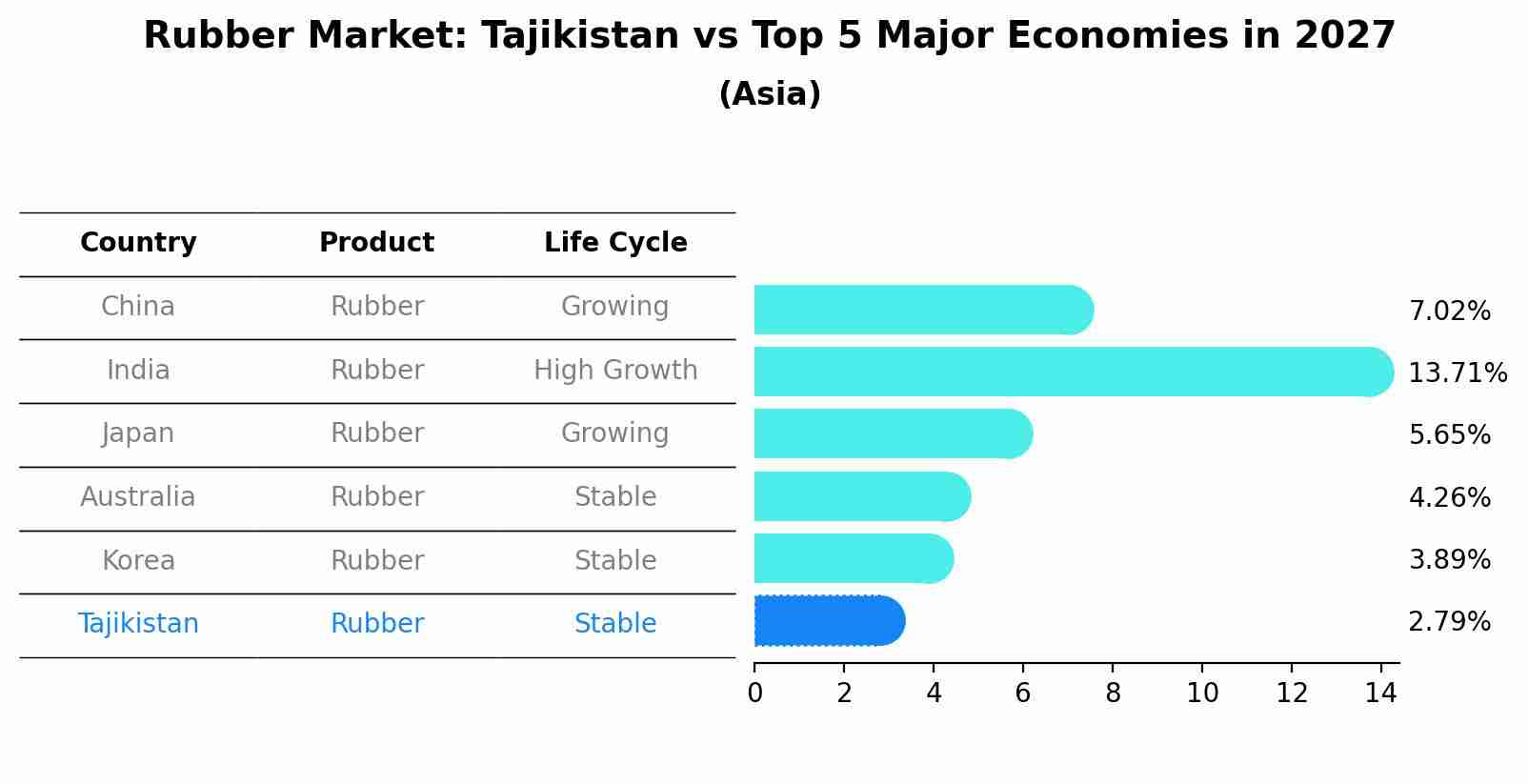Tajikistan Rubber Market | Outlook, Companies, Analysis, Share, Forecast, COVID-19 IMPACT, Size, Value, Growth, Industry, Revenue & Trends
| Product Code: ETC172458 | Publication Date: Jan 2022 | Updated Date: Jun 2025 | Product Type: Market Research Report | |
| Publisher: 6Wresearch | Author: Vasudha | No. of Pages: 70 | No. of Figures: 35 | No. of Tables: 5 |
Tajikistan Rubber Market Size Growth Rate
The Tajikistan Rubber Market may undergo a gradual slowdown in growth rates between 2025 and 2029. Beginning strongly at 3.57% in 2025, growth softens to 2.31% in 2029.

Rubber Market: Tajikistan vs Top 5 Major Economies in 2027 (Asia)
The Rubber market in Tajikistan is projected to grow at a stable growth rate of 2.79% by 2027, within the Asia region led by China, along with other countries like India, Japan, Australia and South Korea, collectively shaping a dynamic and evolving market environment driven by innovation and increasing adoption of emerging technologies.

Tajikistan Rubber Market Overview
The rubber market in Tajikistan is relatively small and underdeveloped compared to other countries in the region. The demand for rubber products mainly comes from industries such as automotive, construction, and manufacturing. The market is primarily supplied by imported rubber products due to the limited domestic production capacity. The government has been making efforts to promote the development of the rubber industry by providing incentives and support to local manufacturers. However, challenges such as lack of infrastructure, limited technical expertise, and competition from cheaper imported products hinder the growth of the market. Overall, the Tajikistan rubber market has potential for growth with the right investments and supportive policies in place.
Tajikistan Rubber Market Trends
The Tajikistan Rubber Market is experiencing growth due to increased demand from sectors such as automotive, construction, and manufacturing. The market is witnessing a trend towards the adoption of eco-friendly and sustainable rubber products, driven by increasing environmental concerns. There is also a growing preference for high-quality and durable rubber materials, leading to a shift towards premium products in the market. Additionally, technological advancements in rubber production processes are shaping the market landscape, with a focus on enhancing efficiency and product performance. Overall, the Tajikistan Rubber Market is expected to continue its upward trajectory, driven by evolving consumer preferences and industrial requirements.
Tajikistan Rubber Market Challenges
In the Tajikistan Rubber Market, some key challenges include limited domestic production capacity leading to a dependency on imports, fluctuating global rubber prices affecting local market stability, lack of advanced technology and infrastructure for rubber cultivation and processing, and limited access to finance for small-scale rubber farmers. Additionally, the industry faces issues related to inefficient supply chain management, inadequate market information and research, and low awareness about sustainable rubber production practices. Political instability, lack of government support, and competition from other rubber-producing countries further exacerbate the challenges faced by the Tajikistan Rubber Market. Overall, addressing these challenges will require strategic investments in technology, infrastructure, and capacity building, as well as policy reforms to support the sustainable growth of the rubber industry in Tajikistan.
Tajikistan Rubber Market Investment Opportunities
The Tajikistan rubber market presents promising investment opportunities due to the country`s growing automotive industry and increasing demand for rubber products. With the government`s focus on infrastructure development, there is a rising need for tires, conveyor belts, and other rubber-based goods. Investors can explore setting up rubber plantations for natural rubber production or establish manufacturing units for rubber products to cater to the domestic market. Additionally, investing in technology and innovation for the rubber industry can enhance productivity and quality, making Tajikistan a potential hub for rubber production in the region. However, it is essential for investors to conduct thorough market research, assess regulatory frameworks, and consider factors such as supply chain logistics and skilled labor availability to capitalize on the opportunities in the Tajikistan rubber market.
Tajikistan Rubber Market Government Policy
The Tajikistan government has implemented policies to promote the development of the rubber market in the country. These policies include providing support and incentives to local rubber producers, such as subsidies for equipment and technology upgrades, as well as offering technical assistance to improve production processes. The government has also focused on increasing domestic rubber cultivation to reduce reliance on imports, aiming for self-sufficiency in the industry. Additionally, there are regulations in place to ensure environmental sustainability and quality control in the rubber production process. Overall, the Tajikistan government`s policies aim to boost the rubber market, enhance local production capacity, and create a more sustainable and competitive industry in the country.
Tajikistan Rubber Market Future Outlook
The future outlook for the Tajikistan rubber market appears positive, driven by increasing demand from various industries such as automotive, construction, and manufacturing. With the country`s growing economy and infrastructure development projects, the demand for rubber products is expected to rise steadily. Additionally, the government`s initiatives to support the manufacturing sector and improve trade relations with neighboring countries could further boost the market. However, challenges such as fluctuations in raw material prices and competition from international markets may impact the growth potential. Overall, the Tajikistan rubber market is poised for expansion in the coming years, presenting opportunities for local producers and international investors to capitalize on the growing demand.
Key Highlights of the Report:
- Tajikistan Rubber Market Outlook
- Market Size of Tajikistan Rubber Market, 2021
- Forecast of Tajikistan Rubber Market, 2031
- Historical Data and Forecast of Tajikistan Rubber Revenues & Volume for the Period 2018 - 2031
- Tajikistan Rubber Market Trend Evolution
- Tajikistan Rubber Market Drivers and Challenges
- Tajikistan Rubber Price Trends
- Tajikistan Rubber Porter's Five Forces
- Tajikistan Rubber Industry Life Cycle
- Historical Data and Forecast of Tajikistan Rubber Market Revenues & Volume By Type for the Period 2018 - 2031
- Historical Data and Forecast of Tajikistan Rubber Market Revenues & Volume By Natural for the Period 2018 - 2031
- Historical Data and Forecast of Tajikistan Rubber Market Revenues & Volume By Synthetic for the Period 2018 - 2031
- Historical Data and Forecast of Tajikistan Rubber Market Revenues & Volume By Application for the Period 2018 - 2031
- Historical Data and Forecast of Tajikistan Rubber Market Revenues & Volume By Tire for the Period 2018 - 2031
- Historical Data and Forecast of Tajikistan Rubber Market Revenues & Volume By Non-Tire Automotive for the Period 2018 - 2031
- Historical Data and Forecast of Tajikistan Rubber Market Revenues & Volume By Footwear for the Period 2018 - 2031
- Historical Data and Forecast of Tajikistan Rubber Market Revenues & Volume By Industrial Goods for the Period 2018 - 2031
- Historical Data and Forecast of Tajikistan Rubber Market Revenues & Volume By Others for the Period 2018 - 2031
- Tajikistan Rubber Import Export Trade Statistics
- Market Opportunity Assessment By Type
- Market Opportunity Assessment By Application
- Tajikistan Rubber Top Companies Market Share
- Tajikistan Rubber Competitive Benchmarking By Technical and Operational Parameters
- Tajikistan Rubber Company Profiles
- Tajikistan Rubber Key Strategic Recommendations
Frequently Asked Questions About the Market Study (FAQs):
1 Executive Summary |
2 Introduction |
2.1 Key Highlights of the Report |
2.2 Report Description |
2.3 Market Scope & Segmentation |
2.4 Research Methodology |
2.5 Assumptions |
3 Tajikistan Rubber Market Overview |
3.1 Tajikistan Country Macro Economic Indicators |
3.2 Tajikistan Rubber Market Revenues & Volume, 2021 & 2031F |
3.3 Tajikistan Rubber Market - Industry Life Cycle |
3.4 Tajikistan Rubber Market - Porter's Five Forces |
3.5 Tajikistan Rubber Market Revenues & Volume Share, By Type, 2021 & 2031F |
3.6 Tajikistan Rubber Market Revenues & Volume Share, By Application, 2021 & 2031F |
4 Tajikistan Rubber Market Dynamics |
4.1 Impact Analysis |
4.2 Market Drivers |
4.3 Market Restraints |
5 Tajikistan Rubber Market Trends |
6 Tajikistan Rubber Market, By Types |
6.1 Tajikistan Rubber Market, By Type |
6.1.1 Overview and Analysis |
6.1.2 Tajikistan Rubber Market Revenues & Volume, By Type, 2021-2031F |
6.1.3 Tajikistan Rubber Market Revenues & Volume, By Natural, 2021-2031F |
6.1.4 Tajikistan Rubber Market Revenues & Volume, By Synthetic, 2021-2031F |
6.2 Tajikistan Rubber Market, By Application |
6.2.1 Overview and Analysis |
6.2.2 Tajikistan Rubber Market Revenues & Volume, By Tire, 2021-2031F |
6.2.3 Tajikistan Rubber Market Revenues & Volume, By Non-Tire Automotive, 2021-2031F |
6.2.4 Tajikistan Rubber Market Revenues & Volume, By Footwear, 2021-2031F |
6.2.5 Tajikistan Rubber Market Revenues & Volume, By Industrial Goods, 2021-2031F |
6.2.6 Tajikistan Rubber Market Revenues & Volume, By Others, 2021-2031F |
7 Tajikistan Rubber Market Import-Export Trade Statistics |
7.1 Tajikistan Rubber Market Export to Major Countries |
7.2 Tajikistan Rubber Market Imports from Major Countries |
8 Tajikistan Rubber Market Key Performance Indicators |
9 Tajikistan Rubber Market - Opportunity Assessment |
9.1 Tajikistan Rubber Market Opportunity Assessment, By Type, 2021 & 2031F |
9.2 Tajikistan Rubber Market Opportunity Assessment, By Application, 2021 & 2031F |
10 Tajikistan Rubber Market - Competitive Landscape |
10.1 Tajikistan Rubber Market Revenue Share, By Companies, 2021 |
10.2 Tajikistan Rubber Market Competitive Benchmarking, By Operating and Technical Parameters |
11 Company Profiles |
12 Recommendations |
13 Disclaimer |
- Single User License$ 1,995
- Department License$ 2,400
- Site License$ 3,120
- Global License$ 3,795
Search
Thought Leadership and Analyst Meet
Our Clients
Related Reports
- Germany Breakfast Food Market (2026-2032) | Industry, Share, Growth, Size, Companies, Value, Analysis, Revenue, Trends, Forecast & Outlook
- Australia Briquette Market (2025-2031) | Growth, Size, Revenue, Forecast, Analysis, Trends, Value, Share, Industry & Companies
- Vietnam System Integrator Market (2025-2031) | Size, Companies, Analysis, Industry, Value, Forecast, Growth, Trends, Revenue & Share
- ASEAN and Thailand Brain Health Supplements Market (2025-2031) | Strategy, Consumer Insights, Analysis, Investment Trends, Opportunities, Growth, Size, Share, Industry, Revenue, Segments, Value, Segmentation, Supply, Forecast, Restraints, Outlook, Competition, Drivers, Trends, Demand, Pricing Analysis, Competitive, Strategic Insights, Companies, Challenges
- ASEAN Bearings Market (2025-2031) | Strategy, Consumer Insights, Analysis, Investment Trends, Opportunities, Growth, Size, Share, Industry, Revenue, Segments, Value, Segmentation, Supply, Forecast, Restraints, Outlook, Competition, Drivers, Trends, Demand, Pricing Analysis, Competitive, Strategic Insights, Companies, Challenges
- Europe Flooring Market (2025-2031) | Outlook, Share, Industry, Trends, Forecast, Companies, Revenue, Size, Analysis, Growth & Value
- Saudi Arabia Manlift Market (2025-2031) | Outlook, Size, Growth, Trends, Companies, Industry, Revenue, Value, Share, Forecast & Analysis
- Uganda Excavator, Crane, and Wheel Loaders Market (2025-2031) | Strategy, Consumer Insights, Analysis, Investment Trends, Opportunities, Growth, Size, Share, Industry, Revenue, Segments, Value, Segmentation, Supply, Forecast, Restraints, Outlook, Competition, Drivers, Trends, Demand, Pricing Analysis, Competitive, Strategic Insights, Companies, Challenges
- Rwanda Excavator, Crane, and Wheel Loaders Market (2025-2031) | Strategy, Consumer Insights, Analysis, Investment Trends, Opportunities, Growth, Size, Share, Industry, Revenue, Segments, Value, Segmentation, Supply, Forecast, Restraints, Outlook, Competition, Drivers, Trends, Demand, Pricing Analysis, Competitive, Strategic Insights, Companies, Challenges
- Kenya Excavator, Crane, and Wheel Loaders Market (2025-2031) | Strategy, Consumer Insights, Analysis, Investment Trends, Opportunities, Growth, Size, Share, Industry, Revenue, Segments, Value, Segmentation, Supply, Forecast, Restraints, Outlook, Competition, Drivers, Trends, Demand, Pricing Analysis, Competitive, Strategic Insights, Companies, Challenges
Industry Events and Analyst Meet
Whitepaper
- Middle East & Africa Commercial Security Market Click here to view more.
- Middle East & Africa Fire Safety Systems & Equipment Market Click here to view more.
- GCC Drone Market Click here to view more.
- Middle East Lighting Fixture Market Click here to view more.
- GCC Physical & Perimeter Security Market Click here to view more.
6WResearch In News
- Doha a strategic location for EV manufacturing hub: IPA Qatar
- Demand for luxury TVs surging in the GCC, says Samsung
- Empowering Growth: The Thriving Journey of Bangladesh’s Cable Industry
- Demand for luxury TVs surging in the GCC, says Samsung
- Video call with a traditional healer? Once unthinkable, it’s now common in South Africa
- Intelligent Buildings To Smooth GCC’s Path To Net Zero


















